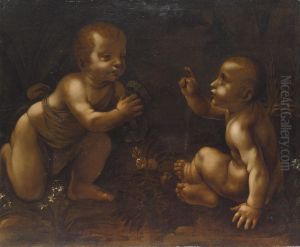Andrea Bianchi, Il Vespino Paintings
Andrea Bianchi, also known by his nickname Il Vespino, was an Italian painter and draftsman active during the late Renaissance period, specifically within the transition to the early Baroque style. Born in 1565 in Bologna, he was part of an era that was rich in artistic innovation and was deeply influenced by the Mannerist movement, which is known for its artificial (as opposed to naturalistic) and elongated figures. Despite the prominence of Mannerism during his early years, Bianchi's work eventually exhibited the early signs of the Baroque movement, which favored realism and emotional intensity.
Il Vespino trained under the guidance of prominent artists of his time but managed to carve out a distinctive style that combined the dynamism and dramatic use of light characteristic of the Baroque with a certain adherence to the elegance and grace of Mannerism. This unique blend made his works stand out among his contemporaries. His contributions to Italian art are primarily in religious and historical paintings, which were commissioned by both religious institutions and private patrons, reflecting the high demand for such works during the Counter-Reformation in Italy.
Over the course of his career, Vespino also engaged in significant collaborations with other artists, contributing to larger projects that were typical of the period, such as the decoration of churches and public buildings. This collaborative environment was crucial for the exchange of ideas and techniques among artists, which further enriched the Italian art scene.
Andrea Bianchi, Il Vespino, passed away in 1607. While perhaps not as widely recognized as some of his contemporaries like Caravaggio or Annibale Carracci, his work nevertheless played a role in the transition between the Renaissance and Baroque periods in Italian art. His legacy lives on in the collections of various Italian museums and in the study of the period's art history, where his contributions to the evolution of Italian painting continue to be acknowledged and appreciated.
